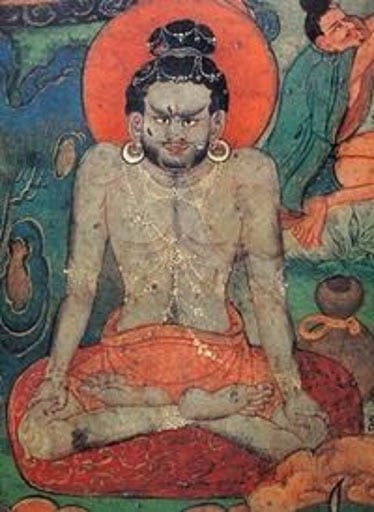Ṣaḍaṅga Yoga's Dhāraṇā Practice: Kumbhaka of Five Nāḍī-Chakras
Translator’s Note
Dhāraṇā is the fourth ancillary yoga practice of the Ṣaḍaṅga yoga system of Vajrayāna. It comes right after the Prāṇāyāma. Here the literal meaning of dhāraṇā is holding/retention. This practice involves chiefly kumbhaka practices wherein the prāṇa vāyu (the ride of consciousness) is made to enter or lock in the Bindu of each of the five chakra’s Avadhūti channel (central channel). In the end, the yogi is able to confine the prāṇa (vāyu) within the bindu on the forehead, and thus the indivisibility of the great bliss and the image of emptiness arise. There is a common view that dhāraṇā means retaining or holding seminal fluid during the practice of karma-mudra (practice with a physical consort). But it is very clear from reading various texts that this is not so. Jamgon Amnye says,
Some see the meaning of dhāraṇā (retention) as the retention of bodhicitta bindu and associate it with the practice of karma-mudra. However, this is not the intended meaning of the tantric treatise. Retention must be in the centre of each of the six nāḍī-chakras.
In Vajrayāna Tibetan Buddhism, Kumbhaka is called the most glorious and ultimate breathing technique. According to the scriptures, Kumbhaka has the ability to merge the sun and moon into one taste in the fire of the navel. It cures all physical and mental illnesses. It takes away thirst and hunger and ultimately bestows immortality. This breathing technique is essential in almost all physical oriented yoga, such as Tummo and other rtsa rlung ‘khrul ‘khor practices. Kumbhaka of prāṇāyāma and dhāraṇā are similar but there are subtle differences in their function and application. Dhāraṇā’s kumbhaka is performed when the yogi has perfected the prāṇāyāma kumbhaka by uniting the sun and moon (upper and lower, air in the right and left channel) into one composite in the central channel of the navel nāḍī-chakra. While dhāraṇā kumbhaka confines the air inside the Bindu of the six chakra’s central channel.
The three signs experience during dhāraṇā
External sign
There is no odour in the downward moving air (apāna vāyu). One gains control over the excrement.
Internal sign
Produces great physical heat due to the blazing of the caṇḍālī (tummo).
Secret sign
After uniting prāṇa and apāna vāyu at the navel and pressing them down to the perineum with holding kumbhaka, if you hold one of them (either prāṇa or apāna vāyu) and let the other go, if the other does not go, it is the sign of uniting prāṇa and apāna vāyu.
In this post, I have translated the yoga postures and techniques applied in these kumbhakas according to Taranatha’s text.
TRANSLATION
I. Navel Kumbhaka (ལྟེ་བའི་བུམ་ཅན/nābhi-kumbhaka):
The dhāraṇā’s navel kumbhaka technique is similar to the navel kumbhaka of prāṇāyāma, except the yogi here must envisage the merging of prāṇa (vāyu) into the navel’s Bindu.
Clear away the residual air with a set of nine breathing purifications.
Inhale a slow and long breath.
At the same time when one ingests or swallows saliva, press the air at the navel.
Draw the apāna vāyu to the navel.
And imagine the entire upper and lower air merging into the Bindu of the navel centre.
By keeping the mind on the Navel’s Bindu without any conceptual thoughts, unite the prāṇa and apāna vāyu at the navel and hold (it there).
If you can't hold it, do a few short inhalations.
If you can't hold it any longer, let go slowly and let the air out.
II. Heart kumbhaka (སྙིང་གའི་བུམ་ཅན/hṛd-kumbhaka):
Heart kumbhaka is also similar to the above.
Just after finishing (holding) the navel kumbhaka, it is raised to the heart centre.
In the vajra cross-legged posture, cross the arms behind the back and pull the big toes from the right and left sides with the hands.
At the same time, move the navel kumbhaka to the heart centre and imagine all the air merging into the heart bindu while remaining in a non-conceptual mind.
Hold the union of prāṇa and apāna vāyu at the heart centre to one’s capacity.
If you couldn’t then you should bring the heart’s kumbhaka back to the navel and repeat it again.
III. Throat kumbhaka (མགྲིན་པའི་བུམ་ཅན/Kaṇṭha-kumbhaka):
Cross the legs.
Support the elbows on the inner knees.
Interlace the fingers, press down from the nape and turn the head upwards, and look sixteen inches away at the space.
Inhale through the mouth.
Hold the pressure or force directly at the nape.
Press the chin on the larynx.
Draw the apāna vāyu upwards straight to the throat.
Imagine the whole air (vāyu) merging into the throat’s Bindu and attending one’s mind there.
Unite the prāṇa and apāna vāyu (ཐུར་སེལ) at the throat and hold it as much as one can.
If you couldn’t then you should bring the throat’s kumbhaka back to the heart centre and repeat it again.
IV. Forehead kumbhaka (དཔྲལ་བའི་བུམ་ཅན/Lalāṭa-kumbhaka):
The forehead kumbhaka is almost as same as above. Hands in the earlier position, pull (the hands) upward from the crown of the head.
Draw the air through the mouth and roll up the tongue into the cavity of the palate. These are the differences.
V. Perineum (area) kumbhaka (གསང་བའི་བུམ་ཅན/guhya-kumbhaka):
One of the heels is fixed to the anus.
Another heel is pressing down from the genital.
Plant both hands one handspan away from the tailbone.
Turn the face upward.
Draw a long and forceful air and press.
Draw the apāna vāyu lots of times from the openings of the anus and genitalia.
Then press the apāna vāyu and the upper air at the bottom of the bowel and leave it there.
Note: This post is for educational and information purposes only.
If you enjoy my posts and translations and want to fuel more posts, click the button below





